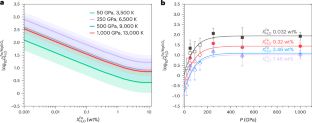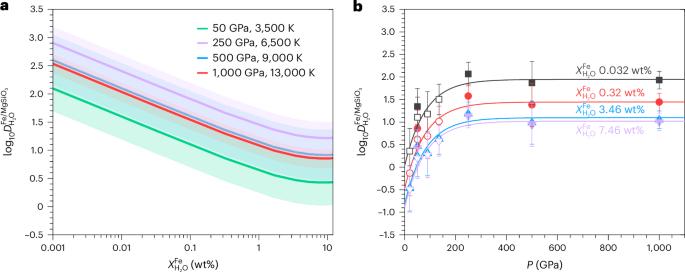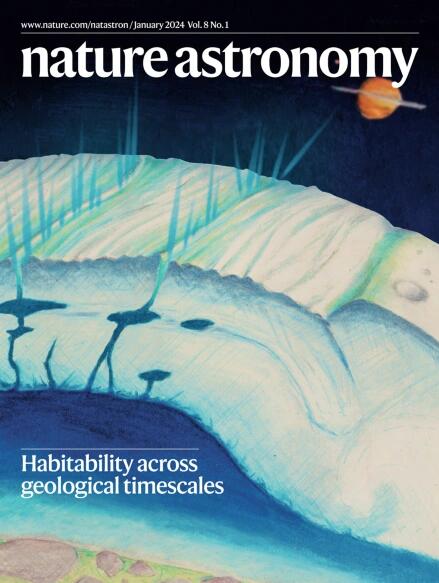The interior as the dominant water reservoir in super-Earths and sub-Neptunes
IF 12.9
1区 物理与天体物理
Q1 ASTRONOMY & ASTROPHYSICS
引用次数: 0
Abstract
Water is an important component of exoplanets, with its distribution, that is, whether at the surface or deep inside, fundamentally influencing the planetary properties. The distribution of water in most exoplanets is determined by yet-unknown partition coefficients at extreme conditions. Here we first conduct ab initio molecular dynamics simulations to investigate the metal–silicate partition coefficients of water up to 1,000 GPa and then model planet interiors by considering the effects of water content on density, melting temperature and water partitioning. Our calculations reveal that water strongly partitions into iron over silicate at high pressures and, thus, would preferentially stay in a planet’s core. The results of our planet interior model challenge the notion of water worlds as imagined before: the majority of the bulk water budget (even more than 95%) can be stored deep within the core and the mantle, and not at the surface. For planets more massive than ~6 M⨁ and Earth-size planets (of lower mass and small water budgets), the majority of water resides deep in the cores of planets. Whether water is assumed to be at the surface or at depth can affect the radius up to 15–25% for a given mass. The exoplanets previously believed to be water-poor on the basis of mass–radius data may actually be rich in water. If water exists in super-Earth and sub-Neptune exoplanets, it is expected to be hidden deep in their cores and mantles, rather than at their surfaces. Exoplanets considered to be relatively dry might actually have abundant water sequestered in their interiors.


内部是超地球和次海王星的主要储水层
水是系外行星的重要组成部分,它的分布,即是在表面还是在内部深处,从根本上影响着行星的性质。水在大多数系外行星中的分布是由极端条件下未知的分配系数决定的。在这里,我们首先进行了ab initio分子动力学模拟,研究了水在1000 GPa以下的金属-硅酸盐分配系数,然后通过考虑水含量对密度、熔融温度和水分配的影响,建立了行星内部模型。我们的计算结果表明,在高压下,水与铁的分区强于与硅酸盐的分区,因此,水会优先留在行星的内核中。我们的行星内部模型的结果对以前想象的水世界的概念提出了挑战:大部分(甚至超过 95%)体积水预算可以储存在地核和地幔深处,而不是表面。对于质量大于~6 M⨁的行星和地球大小的行星(质量较低,水预算较小)来说,大部分水存在于行星内核深处。对于给定质量的行星来说,假设水在表面还是在深处会影响半径达15-25%。以前根据质量-半径数据认为贫水的系外行星实际上可能富含水。
本文章由计算机程序翻译,如有差异,请以英文原文为准。
求助全文
约1分钟内获得全文
求助全文
来源期刊

Nature Astronomy
Physics and Astronomy-Astronomy and Astrophysics
CiteScore
19.50
自引率
2.80%
发文量
252
期刊介绍:
Nature Astronomy, the oldest science, has played a significant role in the history of Nature. Throughout the years, pioneering discoveries such as the first quasar, exoplanet, and understanding of spiral nebulae have been reported in the journal. With the introduction of Nature Astronomy, the field now receives expanded coverage, welcoming research in astronomy, astrophysics, and planetary science. The primary objective is to encourage closer collaboration among researchers in these related areas.
Similar to other journals under the Nature brand, Nature Astronomy boasts a devoted team of professional editors, ensuring fairness and rigorous peer-review processes. The journal maintains high standards in copy-editing and production, ensuring timely publication and editorial independence.
In addition to original research, Nature Astronomy publishes a wide range of content, including Comments, Reviews, News and Views, Features, and Correspondence. This diverse collection covers various disciplines within astronomy and includes contributions from a diverse range of voices.
 求助内容:
求助内容: 应助结果提醒方式:
应助结果提醒方式:


